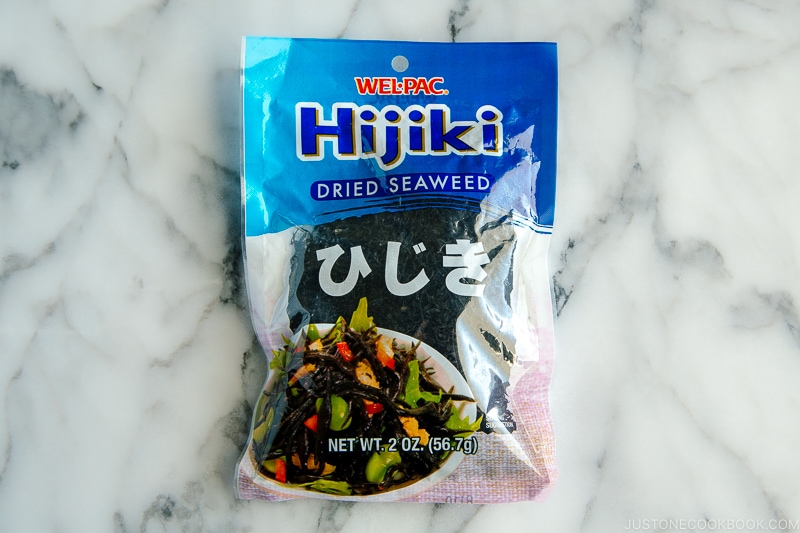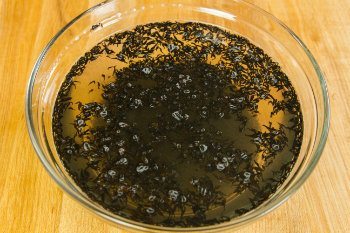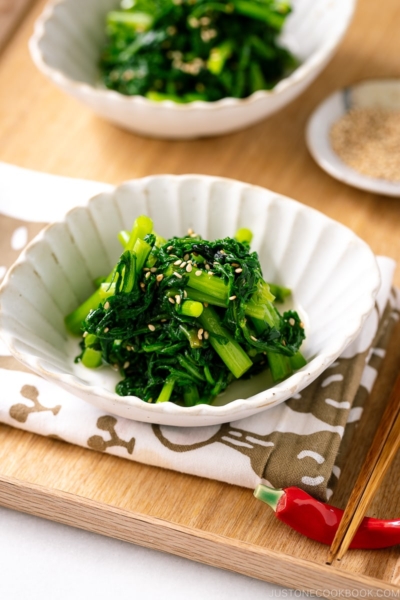A classic Japanese side dish, Hijiki Seaweed Salad features a type of wild sea vegetable that‘s packed with nutrients. Simmered with edamame and deep-fried tofu strips in a savory-sweet broth, this dish is full of flavor and perfect for meal prep. {Vegan Adaptable}

If you’re looking to include more sea vegetables into your diet, you’ll want to give hijiki a try. Resembling dried tea leaves but longer, hijiki is a type of wild sea vegetable that grows on rocky coastlines around Japan, Korea, and China. It has a sweet, clean taste and mushroom-like quality.
In Japan, we often enjoy it as hijiki no nimono (ひじきの煮物), which translates to “simmered hijiki.” It is technically a cooked dish, but you’ll find it called Hijiki Seaweed Salad at Japanese restaurants in the US.
Table of Contents
What is Hijiki Seaweed?

Hijiki seaweed is naturally green or brown in color when it’s hand-harvested by fishermen and divers in the wild. Before it’s packaged, hijiki is boiled and then dried, and this process turns hijiki black. You will need to rehydrate it by soaking it in the water prior to cooking.
Like other edible sea vegetables, hijiki is known for its dietary fiber and essential minerals like iron, calcium, and magnesium. After it’s cooked, it has a pleasant crunch and chewy bite. The taste is more earthy rather than oceany. The Japanese have been enjoying this traditional food as a part of a balanced diet for centuries.
Why You’ll Love This Recipe
- Great textures and flavors: It’s savory, sweet, and pleasantly crunchy
- Versatile: Serve this side dish in a Japanese dinner, lunch menu set, or bento box
- Meal-prep and freezer friendly: Make a big batch to enjoy throughout the week! It keeps in the fridge for 3–4 days or in the freezer for up to a month
- Packed with nutrients: Full of dietary fiber and minerals
Ingredients for Hijiki Seaweed Salad
You can leave out the optional ingredients, but hijiki salad always includes aburaage and edamame.
- dried hijiki seaweed – find it at Japanese supermarkets, Asian grocery stores, natural food stores, or online
- aburaage (fried tofu pouch) – adds protein and a lot of flavor
- carrot – adds color and nutrition
- edamame (young soybeans) – provides plant-based protein and a satisfying bite
- lotus root (renkon) – optional, but it adds a nice crunchy texture
- konnyaku (konjac) – optional; a jelly-like plant food unique to Japanese cuisine that’s very low in calories and high in fiber
- dashi – use homemade dashi, a dashi packet, or Vegan Dashi for vegan/vegetarian
- seasonings – soy sauce, mirin, and sugar
How to Make the Best Hijiki Seaweed Salad
There are various ways to prepare hijiki no nimono, but I really love my mom’s version. This is very close to how she cooks the dish.
- Soak the hijiki seaweed in plenty of water for 30 minutes. In the meantime, prep the other ingredients.
- Sauté the julienned carrots and sliced lotus root. Then, add the rehydrated hijiki, aburaage strips, and konnyaku strips.
- Add the broth and seasonings and simmer for about 30 minutes.
- Add the edamame and continue to simmer until the sauce cooks down and the ingredients soak up the simmering liquid.
- Cool to room temperature so the flavors mingle and settle in. Serve at room temperature.
Cooking Tips
- Season generously – When a dish is eaten at room temperature, you want to be generous with the seasonings so the flavors come through. Do not cut down on the sugar as we use it to balance the salt and enhance the overall taste.
- Don’t skip the fried tofu pouch – The sponge-like texture of the aburaage gives great depth, mouthfeel, and flavor to the dish, so don’t skip it.
- Make a big batch – Simmered hijiki is exactly the kind of dish that Japanese home cooks include in their meal prep. It keeps well and can easily enjoy throughout the week. You can mix it with white steamed rice to make Maze Gohan (Mixed Rice), add on top of soba noodles, or use it to make rice balls.

What to Serve with Hijiki Seaweed Salad
With contrasting textures and a concentrated sweet-savory flavor, Hijiki Seaweed Salad makes a truly unique Japanese dish that highlights the beauty of sea vegetables. I hope you enjoy it.
Try serving Hijiki Seaweed Salad with Grilled Mackerel, Japanese Spinach Salad with Sesame Dressing, White Steamed Rice, (Takikomi Gohan), and Miso Soup for a Japanese-style ichiju sansai meal.
Popular Similar Dishes
- Simmered Kabocha Squash
- Simmered Taro
- Simmered Koyadofu
- Simmered Bamboo Shoots
- Simmered Kiriboshi Daikon

Wish to learn more about Japanese cooking? Sign up for our free newsletter to receive cooking tips & recipe updates! And stay in touch with me on Facebook, Pinterest, YouTube, and Instagram.

Hijiki Seaweed Salad
Video
Ingredients
- ½ cup dried hijiki seaweed (1 oz; increases tenfold after rehydration; I used mehijiki (芽ひじき), the small, soft “buds“ of the hijiki plant; you can also use the long and chewy “stems” called nagahijiki (長ひじき), which are less commonly found in the US)
- 4 cups water (for soaking)
- 2 aburaage (deep-fried tofu pouch) (1.4 oz, 40 g; you can substitute crispy fried tofu cubes from an Asian grocery store, but blanch them first to remove the excess oil)
- 3 oz konnyaku (konjac) (⅓ konnyaku block; optional)
- 3 oz carrot (½–1 carrot)
- ¼ lotus root (renkon) (1.3 oz, 37 g; pre-boiled; optional)
- 1 Tbsp neutral oil
- 2 cups dashi (Japanese soup stock) (use standard Awase Dashi, dashi packet or powder, or Vegan Dashi)
- ⅓ cup shelled edamame (2 oz, 60 g; cooked; optional)
Instructions
- Gather all the ingredients.

- Soak ½ cup dried hijiki seaweed in 4 cups water—10 minutes for mehijiki (bud hijiki) or 30 minutes for nagahijiki (stem hijiki). Meanwhile, prepare the other ingredients.

- Drain to a large fine-mesh sieve and rinse under running water.

To Prepare the Other Ingredients
- Boil water in a small saucepan and pour it over 2 aburaage (deep-fried tofu pouch). This will remove the excess oil on the aburaage. Squeeze out the liquid. Then, cut in half lengthwise and thinly slice crosswise.

- Add some water and 3 oz konnyaku (konjac) to a small pot and boil for 3 minutes to remove the odor. This also helps the konnyaku absorb flavors and improves the texture. Then, slice it into small strips (about the same size as the aburaage slices).

- Cut 3 oz carrot into julienne pieces.

- Cut ¼ lotus root (renkon) into thin quarter pieces.

To Cook the Hijiki Salad
- Heat 1 Tbsp neutral oil in a medium pot over medium heat. Add the carrot and lotus root and cook until they are coated with oil.

- Add the hijiki, then the konnyaku and aburaage. Mix it all together.

- Add 2 cups dashi (Japanese soup stock) and let it boil.

- Add all the seasonings: ¼ cup mirin, 2 Tbsp sugar, and ¼ cup soy sauce. Mix well. Cook covered on medium-low heat for 20–30 minutes.

- Add ⅓ cup shelled edamame.

- Continue to cook, uncovered, to reduce the sauce until you see the bottom of the pan.

To Serve
- Serve as a side to a Japanese meal or pack in a bento lunch box. For convenient meal prep, you can divide the Hijiki Salad into a bento portion in silicone cups for freezing.

To Store
- Store in an airtight container and keep in the refrigerator for up to 3–4 days. You can also freeze it for up to a month.









Made your hijiki salad few days ago.
Really good recipe! ありがとうございます!!
Hi Jules! I’m so glad you liked the recipe! Thank you! 嬉しいフィードバックありがとう!
I was so surprised to find out that my very fussy eater 4 year old son loves hijiki! He leaves the rest of the salad ingredients on his plate but loves to eat the hijiki part, especially when it is mixed with some rice.
Hi Rita! Ahahaha! You never know, I guess! 🙂 Thanks so much for your kind feedback! xo
Hi Nami! I’m so glad you shared the Hijiki Salad recipe! I loved it in Japan and was so happy to find it. My whole family loves it and I can’t keep it in the house because they eat it so quickly. Yesterday I made ume shiso pasta. Today I’m going to make Tofu pizza and Hijiki salad. Thank you for making it easy for me! Katie Hughes
Hi Katie! I’m terribly sorry for my late response. I am so glad to hear that you and your family enjoy Hijiki recipe. Before sharing this recipe, I was quite hesitant as it doesn’t look too appealing to non-Japanese people… but I know a lot of people requested and like this recipe, so I shared the recipe. 🙂 I’m just happy someone like you enjoy this recipe. Thank you for your kind words. Hope you enjoy(ed) the tofu pizza! 🙂 Oh, and ume shiso pasta… happy to hear you liked it! xo
Dear Nami,
I’ve just ordered Hijiki in the internet since it’s nowhere to be found! When I was in Japan I always ordered a portion of this salad at Sukiya. Of course then I didn’t know neither how it was called nor what the ingredients were… Thank god I found your recipe!!!
Quick question… How do you cook edamame exactly? Here we can only buy them frozen.
And how much hijiki are you allowed to eat per day? I heard somewhere that since it contains a lot of iodine it you shouldn’t overdo it…
Thank you!!
Hi Alina! Happy to hear you like this recipe (I know it doesn’t look so appetizing!).
If you get frozen edamamae, follow the package instruction. But usually you need to boil for a few minutes and drain. You can then remove the edamame from the shell.
I read in Japanese and English articles that you have to eat A LOT and EVERYDAY to be dangerous. If you eat normal amount once in a while, it’s completely okay. But please research more if you’re worried. 🙂
Hope you enjoy this dish!
Hi Nami,
THANK YOU SO MUCH FOR THE RECIPE!!! I made it today and half of it is already gone!! 🙂
Simply D-E-L-I-C-I-O-U-S!!!
Aww I’m so happy to hear that! Thank you very much for your kind feedback. 🙂
I’ve noticed that a lot of your recipes have sugar added to them. Would it affect the taste much if I omitted it?
Nevermind, I just saw Susy’s response!
Hi Alex! You can adjust the sweetness as you like. I try to keep my recipe as authentic as possible. 🙂
This recipe looks great except for the addition of white sugar. I’ve soaked my hijiki in water and then simmered it down in apple cider (juice, not vinegar) and it gives it a delicate sweetness without the sugar burn.
Hi Susy! Thank you so much for sharing your healthier option with us! 🙂
Thank you for your beautiful and useful website. I used your hijiki no nimono and inarizushi recipes to share my love of Japanese food with my friends here in Southern Germany, where i am living right now. I had just returned from a visit to Tokyo to visit my former exchange students, and the tastes were just like my “daughters” made for me during my visit. Everyone loved the food, and I have translated your recipes into German, with a link to your website so they can enjoy the pictures, plus directions to the little Japanese grocery store that I visit in Munich.
Hi Dancing Rabbit! I’m so happy to hear you and your friends enjoyed my recipes! Glad to hear you can get ingredients in Munich. I often wonder how hard it is to find Japanese grocery items in other countries. I’m happy to hear you stay in touch with your “daughters” in Japan! My mom stayed in touch with her “parents” in the US for 45 years until they passed away recently. 🙂
I had this dish in Japan for breakfast. I loved it. Don’t be afraid to post, this is what makes your blog different. Keep posting traditional Japanese dishes.
Hi Pigkiki! Thank you so much for your supporting and kind words! Comments like this always keep me going! Thank you!!! xo 🙂
I love Hijiki! I love this dish too much, I can eat it with a huge bowl of rice!!
If there were only Hijiki and cooked rice in the house, I will be happy to eat them for dinner or lunch…or breakfast!
I’d like to make this soon, but I have to make it without Konnyaku & Renkon…since I can’t buy them around here 🙁
Thanks for the great recipe 🙂
Hi Ayako! Me too! Use ingredients you have. I sometimes just use carrots and aburaage besides hijiki. 🙂 Aburaage or small pieces of pork slices give nice flavor. 🙂 Thank you so much for your kind comment!
Looks delicious! I found Hijiki in a Japanese shop in Amsterdam. I used it like wake me. That was not a great succes, but now I understand, it has to be boiled much longer!
Question: with what dishes is this nice to combine? I like al the different small Japanese dishes, but if you want to make a meal out of it, it seems like I have to be in the kitchen all day:-)
Hi Lara! Yes, hijiki needs to be cooked for a longer time, and hydrating doesn’t work. 🙂
My personal choice is to cook hijiki with rice (Takikomi gohan – rice season with soy sauce, mirin, sake, etc). I hope to share the recipe one day. Also, I add it into “Chicken Meatballs” recipe, instead of colorful bell pepper. So delicious! Hope you give these recipes a try!
Hi Nami,
thanks for sharing your Hijiki recipe on your blog. I got to know hijiki Seaweed from a Japanese friend. After trying hijiki, I liked it a lot. However, I have read on the internet that hijiki contains certain a high level of Arsenic. And I really looked up on the internet. Unfortunately, some food agencies in UK even advice consumers do NOT eat Hijiki seaweed due to this reason. Please see the link i attach. I also told my Japanese friend about what I read. After looking on the internet, he said that he agrees with me. So I am actually not quite sure about whether it is okay to eat Hijiki or not.
http://www.ausfoodnews.com.au/2010/08/13/consumers-advised-not-to-eat-hijiki-seaweed.html
Hi Judy! Thank you for sharing the information with us! I also read some articles too. It looks like if you don’t eat A LOT of hijiki EVERY DAY, the risk is not high. I think this is an issue when you consume so much hijiki… but no one really eat that much hijiki anyway. So the basic summary I learned from reading was to eat hijiki occasionally then it doesn’t affect our health.
However, this is up to a person’s comfortable level regarding this issue. Personally I don’t eat it everyday or even every week (maybe once a month at most?) so as long as research result doesn’t change, we should be okay to eat. Hope this helps. 🙂
I just discovered your site and I love it! I returned yesterday from a trip to Japan. The first half of my trip was spent with a Japanese vegetarian man. We ate so many wonderful things. Your site is a great resource. Thank you for sharing so many recipes.
Hi Rachel! Welcome to Just One Cookbook! I hope you had a great time in Japan. Hope my site has some recipes that you enjoyed while you were traveling in Japan. 🙂
I love hijiki salad and have been meaning to make it for ages! Usually I buy it from Atari-ya in London but now I will try your recipe! Thanks very much (:
Hi Sera! Good to know you can get Hijiki in London too! I think there are more real Japanese foods like Hijiki in big cities. I hope you enjoy this dish! 🙂
Hello Nami,
I’m glad you share this hijiki salad with us. My Japanese friend once made this for me when I was pregnant and she said this is her all time super food. I then was thinking how to made this salad but didn’t manage because I didn’t know that the hijiki has to be cooked…….;)
Thanks a lot Nami!
Hi Penny! You’re welcome! It’s a very common home cook meal, and a lot of us grow up eating this dish. 🙂 Yes, hijiki needs to be cooked before using it. 🙂 Thank you for your comment!
I love hijiki salad!! When I went to school in japan this was one of my favorite dishes!!!!
Thank you Jhiselle! I love the texture and flavor of hijiki. I like to eat it cold in summer too. Thank you for your comment! 🙂